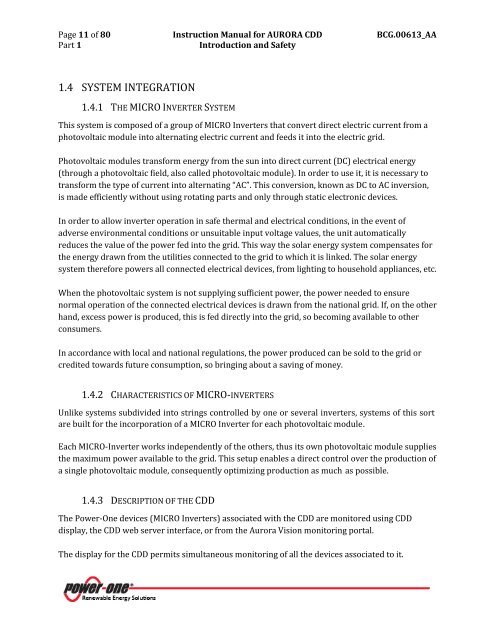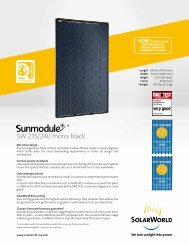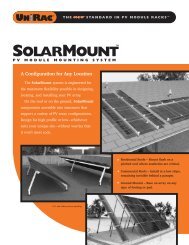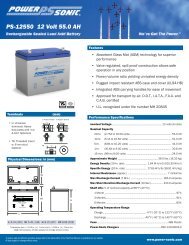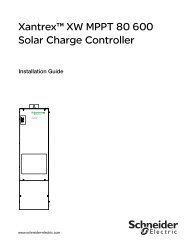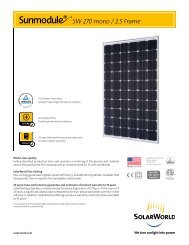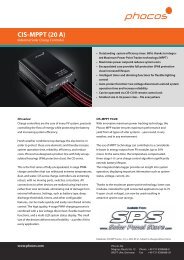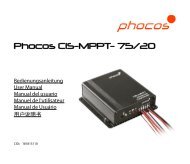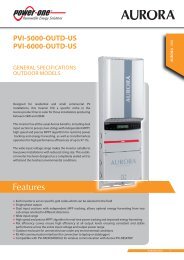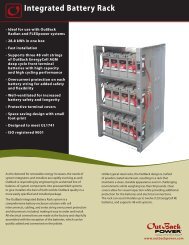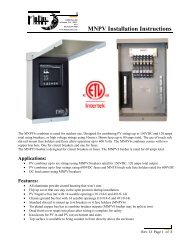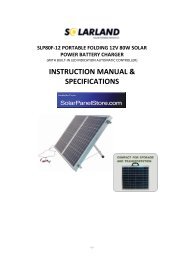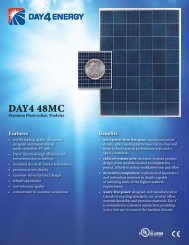THE MANUAL: AURORA CDD - the Solar Panel Store
THE MANUAL: AURORA CDD - the Solar Panel Store
THE MANUAL: AURORA CDD - the Solar Panel Store
Create successful ePaper yourself
Turn your PDF publications into a flip-book with our unique Google optimized e-Paper software.
Page 11 of 80 Instruction Manual for <strong>AURORA</strong> <strong>CDD</strong> BCG.00613_AA<br />
Part 1<br />
Introduction and Safety<br />
1.4 SYSTEM INTEGRATION<br />
1.4.1 <strong>THE</strong> MICRO INVERTER SYSTEM<br />
This system is composed of a group of MICRO Inverters that convert direct electric current from a<br />
photovoltaic module into alternating electric current and feeds it into <strong>the</strong> electric grid.<br />
Photovoltaic modules transform energy from <strong>the</strong> sun into direct current (DC) electrical energy<br />
(through a photovoltaic field, also called photovoltaic module). In order to use it, it is necessary to<br />
transform <strong>the</strong> type of current into alternating “AC”. This conversion, known as DC to AC inversion,<br />
is made efficiently without using rotating parts and only through static electronic devices.<br />
In order to allow inverter operation in safe <strong>the</strong>rmal and electrical conditions, in <strong>the</strong> event of<br />
adverse environmental conditions or unsuitable input voltage values, <strong>the</strong> unit automatically<br />
reduces <strong>the</strong> value of <strong>the</strong> power fed into <strong>the</strong> grid. This way <strong>the</strong> solar energy system compensates for<br />
<strong>the</strong> energy drawn from <strong>the</strong> utilities connected to <strong>the</strong> grid to which it is linked. The solar energy<br />
system <strong>the</strong>refore powers all connected electrical devices, from lighting to household appliances, etc.<br />
When <strong>the</strong> photovoltaic system is not supplying sufficient power, <strong>the</strong> power needed to ensure<br />
normal operation of <strong>the</strong> connected electrical devices is drawn from <strong>the</strong> national grid. If, on <strong>the</strong> o<strong>the</strong>r<br />
hand, excess power is produced, this is fed directly into <strong>the</strong> grid, so becoming available to o<strong>the</strong>r<br />
consumers.<br />
In accordance with local and national regulations, <strong>the</strong> power produced can be sold to <strong>the</strong> grid or<br />
credited towards future consumption, so bringing about a saving of money.<br />
1.4.2 CHARACTERISTICS OF MICRO-INVERTERS<br />
Unlike systems subdivided into strings controlled by one or several inverters, systems of this sort<br />
are built for <strong>the</strong> incorporation of a MICRO Inverter for each photovoltaic module.<br />
Each MICRO-Inverter works independently of <strong>the</strong> o<strong>the</strong>rs, thus its own photovoltaic module supplies<br />
<strong>the</strong> maximum power available to <strong>the</strong> grid. This setup enables a direct control over <strong>the</strong> production of<br />
a single photovoltaic module, consequently optimizing production as much as possible.<br />
1.4.3 DESCRIPTION OF <strong>THE</strong> <strong>CDD</strong><br />
The Power-One devices (MICRO Inverters) associated with <strong>the</strong> <strong>CDD</strong> are monitored using <strong>CDD</strong><br />
display, <strong>the</strong> <strong>CDD</strong> web server interface, or from <strong>the</strong> Aurora Vision monitoring portal.<br />
The display for <strong>the</strong> <strong>CDD</strong> permits simultaneous monitoring of all <strong>the</strong> devices associated to it.


